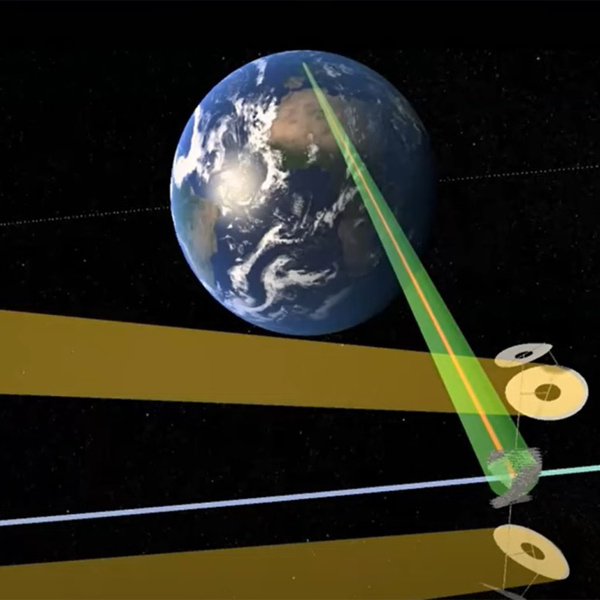
The U.K.-based Space Energy Initiative has set its sights on commercializing space-based solar power (SBSP) by 2035 as a renewable baseload option for the global effort to reach net-zero-emissions energy.
SBSP as a concept is not new, but interest in the technology has been stymied by technological and financial limitations. David Homfray, technical lead for the SEI, says those factors are changing in ways that now make SBSP deployment more viable.
 The UK-based Space Energy Initiative wants to deploy solar energy technology in space by 2035 that can capture light perpetually and transmit it to Earth. | Satellite Applications Catapult
The UK-based Space Energy Initiative wants to deploy solar energy technology in space by 2035 that can capture light perpetually and transmit it to Earth. | Satellite Applications Catapult“Space-based solar power is a massive challenge; it’s going to be similar to an Apollo mission,” he said during a July 12 webinar hosted by Satellite Applications Catapult, one of Innovate UK’s research and development centers.
The catapult is a founding member of SEI, which has grown to a 50-member organization that established working groups to develop SBSP over the next 12 years, said Homfray, who is also space energy lead at SEI. Members of the initiative include U.S.-based Teledyne Technologies and KBR.
“The Americans are extremely invested in this, and we’re working in China and Japan, and Australia and Europe are interested as well,” he said.
The approach SEI is focusing on would require launching a spacecraft that is larger but lighter than the International Space Station (357 feet) and has big mirrors affixed to it. Sunlight would reflect off the mirrors onto photovoltaic modules and be transformed into radio waves. A transmitter would then send those waves to grid-connected ground receivers that take up about the same amount of space as an average solar array.
Deployment of the technology in space means the satellites could capture light perpetually, unlike their land-based counterparts.
Here are three things Homfray says about SBSP: as an option for net-zero, why it’s viable now and what SEI’s development timeline looks like.
Why SBSP?
Reaching net-zero energy by 2050 presents a unique set of challenges, not the least of which is the pace at which change must occur.
“By 2050, we need to have replaced around 40 billion MWh, and with around 10,000 days to do it, that would be about 4 MWh a day,” Homfray said. Collecting solar in space, he added, would provide 13 times as much energy as is generated from solar technology on average today.
SBSP is not the only clean energy solution needed for the net-zero transition, but SEI’s members believe it can be an important part of it.
The initiative, therefore, aims to demonstrate that deploying solar in space as a baseload power solution will be affordable, reliable and scalable.
Why Now?
Traditionally, launching a spacecraft is very expensive, reaching $65,000/kg, according to Homfray. However, potential commercialization by companies like SpaceX and Blue Origin is going to bring per-launch costs down.
“If SpaceX develops their Starship, or similar companies develop fully reusable, heavy-launch vehicles, then we really are talking about being able to lift quite heavy mass” for each launch, he said.
Lowering launch costs will be critical for SBSP, which would require many launches to bring parts to space for construction.
“Space-based solar power should be more thought of as being a mobile phone producer than it is as large spacecraft,” Homfray said. “We’re going to build lots of modules, and we’re going to assemble them in space.”
Application of terrestrial-based solar technology to the SBSP concept also is helping the initiative lower its estimated project costs.
SEI expects the cost of building a SBSP facility to be less than a new nuclear facility.
Costs aside, SBSP will only reach its potential through deployment of a fleet of satellites, which Homfray said will require ongoing initiatives focused on making the space industry sustainable.
What’s the Timeline?
SEI has built a 12-year SBSP program that is divided into four phases.
The first phase is dedicated to de-risking the technology so “there are no fundamental technological challenges in our way,” Homfray said. In phase 2, the initiative will deploy demonstration projects with a goal of producing 6 MW of solar power from space.
SEI will work on commercializing SBSP in phases 3 and 4.
“In phase 3, we’ll put around about a 180-MW spacecraft up there … and phase 4 is where the technology is industrialized; it’s all about gigafactories and manufacturing throughput,” Homfray said.
If the plan succeeds, he added, SBSP can access a $5 trillion/year energy market and “inspire the next generation to take part in this net-zero race.”

